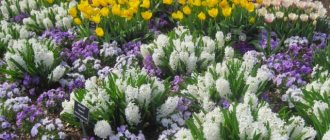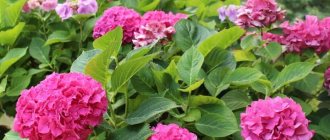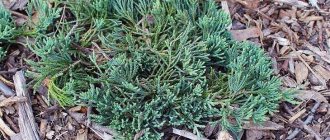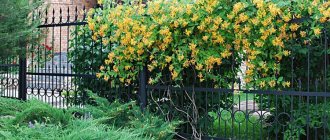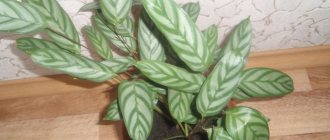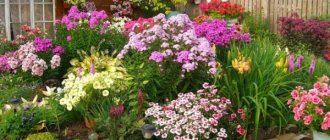- Lily of the Incas or Peruvian lily, came to us from South America. This is a very beautiful perennial plant, highly valued for its ornamental flowers, and also for the fact that it has a long shelf life as a cut flower. In industrial greenhouses, alstroemeria is forced twice a year.
If you don't have enough exotics in your garden, then this is the plant for you! Alstroemeria flowers
are collected in racemose inflorescences, and when they bloom, they resemble exotic butterflies that accidentally flew into a flowerbed in search of nectar. Alstroemeria is a fairly tall plant, the height of some varieties ranges from 80 cm to half a meter.
The color of alstroemeria flowers is the most diverse: yellow, red, pink, and soft purple, almost always with spots on the petals. In addition, alstroemeria petals are decorated with dark longitudinal streaks, which become thinner and shorter closer to the center of the flower. Alstroemeria flowers resemble lily flowers, only small, only about 6 cm in diameter.
Sowing alstroemeria seeds
When growing alstroemeria from seeds
Flowering will occur in the third year.
Alstroemeria seeds
can be sown directly into the ground in April-May. By sowing seeds in February-March for seedlings, you can achieve flowering in the second year. To sow seeds, take 2 parts leaf soil and 1 part turf soil, mix well. Place the alstroemeria seeds on the ground, press them lightly, and lightly dust them with soil on top. Place the container with the planted seeds in a plastic bag and send it for stratification.
Alstroemeria seed stratification
carried out for a month at a temperature of +2 +5 o C. After exposure to low temperatures, alstroemeria shoots appear within 10-20 days, but some seeds can germinate within a month.
At the end of May - beginning of June, after the threat of frost has passed, alstroemeria seedlings can be planted in open ground.
Alstroemeria prefers fertile, well-drained, acidic soil. It grows well in partial shade, but in open sunny areas the flowering of alstroemeria will be more friendly and bright.
Reproduction methods
Astralmeria flowers are propagated by division or using seeds.
A plant grown from seeds will begin to bloom no earlier than in one to two years. It is worth knowing that seeds collected with your own hands are unlikely to retain the varietal properties of their “parents”.
The seed method is usually used by breeders to obtain new varieties. But if you have seeds, why not try to grow alstroemeria from them? It is advisable to immediately sow them in open ground at the end of April or in May, when the soil and air are well warmed up and there is no risk of return frosts. The first sprouts will appear in about three weeks.
You can sow seeds for seedlings at home. This method is good because in April-May, full-fledged plants are planted in open ground, which during the growing season will have time to get stronger and gain strength before the dormant period. But the seedlings will adapt to the new conditions for some time after transplantation, and may become sick.
Before sowing (in open ground or for seedlings), the seeds must be prepared. They are soaked in water for several hours, then placed in a damp cloth, wrapped in parchment to retain moisture, and placed in the bottom compartment of the refrigerator for a month.
Seeds are sown in containers filled with nutrient substrate to a depth of 1 cm. Sowing time is approximately the end of February or the beginning of March. The containers are covered with glass or film and placed in a cool place at a temperature of 18-20 °C. Periodically, the covering is removed to ventilate and moisten the soil, but this is done quite rarely.
It is recommended to plant the seeds immediately in disposable cups, so as not to have to dive later. It’s even better to take peat pots, which can then be immediately placed in open ground without disturbing the young seedling. If the seeds were sown in a common container, then picking should be done when three true leaves appear on the sprouts.
Two weeks before transplanting seedlings into open ground, they must be hardened off. To do this, the pots are taken outside, each time lengthening the “walk” time. Once the plants can be in the fresh air around the clock without any problems, they can be planted in the garden bed.
The division method is much simpler and more productive. Every two to three years after the plant has flowered, the alstroemeria rhizome can be divided into two or more divisions. To do this, an adult healthy bush is dug out of the ground, and then the root is cut into several parts with a sharp, disinfected knife. The main thing is that each of them has several powerful stems and part of the rhizome.
The resulting cuttings are planted at a new place of residence, having previously treated the sections with wood ash or crushed activated carbon.
Alstroemeria care
Throughout the growing season, do not forget to weed, fertilize, and water. In autumn, when frost sets in, the top part of the plant is cut off and the rhizome is dug up. The earthen lump needs to be slightly dried so that the roots do not rot during storage. Store in the same way as dahlia tubers, in a cellar or basement at positive winter temperatures.
In spring, the alstroemeria rhizome can be divided into divisions. However, I do not recommend dividing a plant that is too young and has a small root. Otherwise, you can lose your alstroemeria. When the rhizome grows, then without harming the mother plant you can get several divisions of alstroemeria with 10-15 renewal points.
After dividing, do not forget to treat all sections with crushed coal to prevent the development of rot. Alstroemeria segments that are too small can suffer for a long time, and they bloom only in the third year.
Alstroemeria blooms from late June to August. Flowering will be abundant if fertilizing is carried out with complete complex fertilizers. Don't forget to monitor the acidity of the soil. When acidity decreases, leaf chlorosis is possible.
In general, alstroemeria is not very affected by diseases. However, in the absence of drainage, in conditions of high air humidity, alstroemeria is affected by gray mold (botrytis). After prolonged rains, in order to prevent the disease, water the rhizomes, as well as spray the entire plant with a solution of foundationazole or other fungicide according to the instructions. The treatment should be repeated 2-3 times with a break of a week.
The main pests of alstroemeria: spider mites, thrips, slugs, leaf-eating caterpillars and beetles. Karbofos, fitoverm, actellik, actara and other drugs are effective against them. When working with chemicals, be careful and follow safety rules.
Alstroemeria (sometimes found - Alstroemeria) - the flowers are incredibly beautiful, and therefore popular. A bouquet made of alstroemerias, and even in combination with popovnik (large chamomile) and fern stems, looks luxurious and elegant, and its price (which is important) is not at all burdensome for the budget. After all, if outlandish and luxurious flowers need to be imported “from overseas,” then growing alstroemeria in your own flower garden will not be particularly difficult for anyone, even an inexperienced gardener.
Diseases and pests of alstroemeria
The South American beauty is resistant to disease, but if the watering regime is not followed, it can get sick and even die. Pests rarely appear on alstroemeria, but in the open ground, parasitic insects often move to the flower from neighboring crops.
Diseases
Excessive watering leads to the development of gray rot, which manifests itself as a gray fluffy coating on the above-ground part of the bush. To revive the plant, the affected areas are cut out and the soil is generously sprayed with fungicide. In addition, it is necessary to reconsider the irrigation scheme. If the flower is severely damaged, it cannot be saved. Such a specimen should be dug up and destroyed. This will prevent the spread of gray rot to neighboring plantings.
Pests
The main enemies of alstroemeria are:
- spider mite;
- caterpillars.
The former is combated with acaricides, and the latter with insecticides. Among the universal remedies one can note Akarin, Aktar, Aktellik.
Alstroemeria: cultivation and care
In its appearance, alstroemeria is very reminiscent of lilies and daylilies. Although they are often confused, they are different flowers. But in terms of growing technology, this flower is very similar to daylily. It can also be grown (propagated) both by seeds and by dividing the mother bush. Of course, the second method is much simpler, not to mention the fact that alstroemeria planted in this way will bloom much earlier. But, alas, it is not always possible to buy a piece of the exact variety and color that you want. In this case, you will have to grow it yourself. Alstroemeria from seeds is not difficult to grow. This is how it is grown, more familiar to gardeners. That is, you can use both seedling and non-seedling methods, directly into open ground. But growing alstroemeria seedlings is still more effective and reliable. It is best to sow seeds to obtain seedlings in late winter - early spring. The process of growing it is very simple and is no different from most vegetables. It is planted in the flower garden at the same time as, that is, when the weather is consistently warm. In most cases, this period occurs at the end of May - beginning of June.
Over time, when the alstroemeria bush has reached a decent size, you can already take cuttings from it for further propagation. It is preferable to divide alstroemeria bushes after the plant blooms, in the summer. But along with the summer division of bushes, spring division is also practiced - with the beginning of the growing season, and autumn - after the second flowering.
Note! There is no need to strive to get a lot of cuttings from the bush. Especially if the bush is not yet very large. It is better to divide into two or three parts, but so that each has strong, developed roots. Such divisions will take root faster and bloom earlier.
Planting alstroemeria
When choosing a place for planting, you must be guided by the fact that alstroemeria requires a lot of light and good, light soil to bloom. On heavy soils it is unlikely to obtain lush flowering. But there's nothing to worry about. Such soil can be lightened by adding a cultivator. As a ripper, you can use what you have on hand: peat, compost, manure (rotted) and the like.
Keep in mind! Although good lighting for alstroemeria is one of the keys to successful cultivation, overheating of the soil can negatively affect flowering. At soil temperatures above +23 degrees, alstroemeria begins to intensively grow its root system. This can be useful if you want to quickly get a bush suitable for subsequent division. But you can’t wait for flowering. It will help protect the earth from overheating.
Alstroemeria care
Watering
Overmoistening is unacceptable! This is one of the reasons why heavy soil is unsuitable for alstroemeria. Due to excess moisture, the roots of the flower rot, which will inevitably lead to its death. Therefore, if the summer is not dry, then you can do without it altogether. Mulch will help retain the necessary moisture.
Top dressing
Without regular growth, it is unlikely that alstroemeria will bloom luxuriously. And you need to apply fertilizer often. At least three times a month. For fertilizing, you can use both mineral and organic fertilizers. From the beginning of the growing season until buds set, potassium fertilizers with a high nitrogen content are preferred. With the appearance of buds and during the flowering period, the nitrogen content in the fertilizer decreases, but the percentage of phosphorus increases. Any of these fertilizers can be easily purchased, but you can also make your own from very well-rotted mullein or bird droppings. It is advisable to add wood ash or ash.
Wintering
In order to protect the flower from winter frosts, after trimming the shoots (to about ten centimeters in height), it is enough to cover it with any available material: fallen leaves, peat, sawdust, etc. If the winters in your area are very frosty, and especially if the alstroemeria bushes are still very young, then you can do the same - dig them up and store them in the cellar until the next season. But in most cases, alstroemeria tolerates wintering well even without such radical measures. This especially applies to zones with a temperate climate, not to mention the southern regions, where it can do without any shelter.
Alstroemeria cut
In addition to exquisite beauty, bouquets made from alstroemerias are highly durable. Such a bouquet will delight you for a very long time. It is able to maintain its freshness for up to a month or more. But if you are buying a bouquet, then give preference to one with the maximum number of unopened, but already colored buds. Follow the same guidelines when cutting flowers in your flower garden. Unopened buds will open well in a vase with water. Before placing flowers in a vase, the lower third of the stem must be cleared of leaves.
Site search
Sections of the site
Latest articles
Latest comments, questions and answers to them
- Svetlana on Last March 8th they gave me a hyacinth with a bulb. ABOUT…
- Evgen on The most common pests of flower decoration…
- Uncle Cactus on No question! Succulents get along well with each other...
- Vladislav on Good day everyone! Please tell me,…
- Uncle Cactus on Most likely, your money tree is affected by the shield...
- Julia on
Growing an indoor garden requires a lot of effort and time to organize the care of green pets. But in addition to this, the florist must have a good understanding of flowering beauties and their varieties. After all, there are representatives of the flora who are undeservedly ignored. We are talking about Alstroemeria domestica flowers, which belongs to the Alstroemeriaceae family. Look at the photo of alstroemeria flowers - they illustrate the richness of shades and the special exquisite beauty of the buds:
“Alstroemeria” in the language of flowers means “cute”, “lovely”, “desire to make a compliment”. A bouquet of this type of flowers is usually given to those girls who are in constant motion.
The name of the flower was given by Carl Linnaeus in honor of the Swedish botanist Claes Alströmer. The plant can be found wild in South America and in the cold regions of the Andes Mountains.
On one stem of the plant you can find approximately 10-15 small flowers. Their size is 5 centimeters in diameter. When you look at the flowers, you get the impression that they have specks and lines drawn on them. Flowers have a variety of colors: yellow, orange, pink, red, crimson, white, burgundy, purple.
The leaves on the flower are narrow, medium in size, and green in color. The flower reaches one and a half meters in height. This plant blooms almost the entire summer period, starting in mid-June. It is often grown specifically for cutting, since a bouquet of them can last for a very long time - up to two weeks.
At home, alstroemeria is grown as an evergreen crop, the flowering of which depends on the time of sowing the seeds. Well, and another portion of colorful photos of various varieties and cultivars:
Alstroemeria varieties for growing in the garden
Hybrid varieties are most often grown in garden plots. There are quite a few of them, but the most widespread are the following:
- King Cardinal. One and a half meter bushes with underdeveloped peduncles, therefore, require good lighting. If there is not enough light, the flowers begin to lie down. Scarlet petals form inflorescences similar to an orchid. The flowering period begins in spring and continues until autumn.
- Virginia. A relatively miniature representative of alstroemeria, usually growing no higher than 70 centimeters. Snow-white inflorescences with a wavy edge bloom on powerful stems from June until the onset of the first frost.
- Regina. One of the most popular hybrids in garden culture. Its lanceolate-shaped leaves have a rich dark green color. The flowers are funnel-shaped. The petals are pink with brown streaks. Umbrella-shaped inflorescences consist of 10 or 15 flowers. The flowering period lasts from late June to mid-September.
- White Wings. Tall hybrid. Bushes with powerful shoots grow up to two meters. The petals are snow-white and stand out beautifully against the background of large leaf plates. Flowering continues throughout the summer season with a break of several weeks.
- Orand Queen. A compact alstroemeria hybrid (no more than 70 centimeters in height) is distinguished by the unusual apricot color of its inflorescences. The petals have brown spots.
There are many more varieties of this South American beauty, but they are less popular. You should choose a hybrid taking into account the height of the bushes and flowering time, since this crop will decorate the flower bed in the garden and should fit into the overall landscape.
Growing home alstroemeria and caring for the plant
Alstroemeria prefers moderate temperatures. In summer, room temperature will be enough, but no more and no less than 20-22 degrees Celsius, and in winter - 13-15 degrees Celsius, minimum - 8 degrees Celsius, despite the fact that the flower can withstand even slight frosts. But they all equally do not tolerate heat. Please note that at temperatures above 28 degrees Celsius, the plant freezes in growth, quickly drops flowers, and fades. Too high an air temperature in winter is an obstacle to the formation of buds on a flower, and accordingly the plant will not be able to bloom. Growing homemade alstroemeria requires regular air spraying and protection from dry air from heating devices getting on its buds. Under the influence of dry air, all foliage and accumulated color may be shed.
The flower is light-loving, and in no way can it be classified as a plant that tolerates shaded places, however, if in autumn and winter it can be placed on a window located on the south side, then in spring and summer it requires shading during the daytime. Caring for the home alstroemeria plant includes regular watering and fertilization with a predominance of potassium and phosphorus. With a high percentage of nitrogen, excessive growth of green mass and lack of buds may be observed.
In order for the plant to bloom well, the day must be at least 14 hours long, so the flower is illuminated with fluorescent lamps.
In spring and summer, it is recommended to water regularly, but not abundantly. The soil should have time to dry before subsequent watering. In winter, watering should be limited. The flower does not tolerate stagnation of water in the roots or excess moisture, but dry soil will not lead to anything good. During the growing season, it is advisable to water the plant in such a way that the soil is always slightly moist. By the way, water for irrigation should be soft and free of chlorine.
It is recommended to fertilize Alstroemeria flowers, but it is necessary to monitor the nitrogen content; there should not be a lot of it. Transplantation... as for it, it is recommended to replant the flower every year in the spring. The soil should consist of leaf soil, peat, humus, perlite and pine bark in a ratio of 2:1:1:1:1. The acidity of the soil should be weak. Drainage is required.
Look at the photo of alstroemeria flowers, which are properly and regularly cared for:
Alstroemeria - caring for cut flowers
Attractive flowers are used for mono-bouquets and for various combinations. With normal care, you can enjoy alstoromeria for 2 weeks. To keep alstroemeria in a vase for a long time, follow these recommendations:
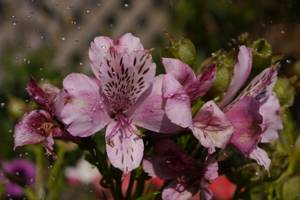
- First, remove the lower leaves from the trunks so that they are not in the water. Otherwise, they will rot and spread rotten microbes.
- Cut the stems at an angle, removing 3 cm. This should be done directly under running cool water.
- Fill the vase with cool liquid, add a little sugar, taking into account that there should be 1 tbsp per 1 liter. spoon. It is possible to use special materials for caring for cut flowers.
- Do not place the vase directly under the open rays of the sun, in an extremely dark place or in a draft.
- It is necessary to replace the water after about a day or, in extreme cases, after 2. At this time, thoroughly wash the stems and the inside of the vase. Cut the stem a second time as previously advised.
Growing alstroemeria from seeds in a pot
The alstroemeria flower propagates by seeds or by dividing the rhizome. Seeds should be sown in February. And in May you can transplant them into open ground. The soil must contain peat. It is recommended to stratify the seeds at a temperature of 2 to 4 degrees Celsius for one or two months, later the temperature should be increased to 20-25 degrees Celsius.
Growing alstroemeria from seeds in seedlings allows you to obtain planting material for decorating the garden and windowsill. Such plantings look great on balconies and loggias. This type of plant prefers warmth and moisture, so before you start germinating the seeds, you should definitely soak them in water for at least 5-6 hours. Afterwards, it is recommended to plant them in a plastic container or in a wooden tray, which should be pre-filled with a mixture of river sand and leaf soil. Moreover, a separate hole is formed for each seed, and the distance between them should be at least three centimeters. After you have planted the seeds, sprinkle them with substrate and water them well. Later, cover the container with plastic wrap. You can remove the film no more than once a day for a couple of minutes.
The place where the trays with seedlings are located should be warm and lit. Under the film, the air temperature should be 22 degrees Celsius, otherwise the seeds will not sprout. If all the above conditions are met, the seeds will produce seedlings in a week or 10 days.
After about two weeks, when you notice 3-4 leaves on young plants, they should be hardened off, gradually increasing the time they remain without a protective film. However, this option for germinating seeds is suitable in cases where you want to leave the seedlings at home. Alstroemeria flowers in a pot will delight you with a lush bush and abundant flowering, if you choose the right container. For 1 bush, a large pot with a volume of at least 5 liters is required.
For flowers that you later plan to transfer to open ground, it is advisable to carry out the stratification procedure, that is, germination at a temperature no higher than five degrees Celsius. Of course, in such a case, no more than half of the seeds will sprout, and this will take not a week or 10 days, but 2-3 weeks. However, the resulting seedlings will be more resistant to temperature changes and will even be able to safely survive spring frosts
During the entire growing season, do not forget to weed. In the autumn, when frosts arrive, the top part of the plant is cut off and the roots are dug up. It is recommended to dry the earthen ball so that the roots do not rot during storage. It can be stored in a cellar or basement at positive winter temperatures.
And now another photo of alstroemeria, illustrating the richness of variations in bud colors:
Remember, when you work with a flower, it is better to use gloves, as the juice of its leaves can cause irritation on the skin.
When alstroemeria begins to bloom, it is advisable to place it in a pot that is large in volume and size. It is recommended to place the pot close to the window.
Some flowers seem to be the living embodiment of fairy-tale images, instantly sinking into the soul with their enchanting delicate beauty, fragility and grace. This is the favorite of florists - alstroemeria, which can be grown not only in specialized greenhouses, but also in open ground. Caring for this bright miniature lily, despite its exotic nature, will not take much time; even novice gardeners can handle it.
Description of the plant
The stems of the plant are straight and flexible with thin, curved, alternately arranged leaves. The shape of such a flower is called zygomorphic, they are collected in inflorescences in the form of umbrellas at the top of the stem, and have six petals with six long stamens inside, and are arranged three in two circles. What is interesting is that there are no repetitions in the shape and color of the petals (there are striped petals). There are more than 12-15 flowers on one stem, about 5 cm in diameter. The flowers reach a height of up to 90 cm. The plant prefers warmth and moisture. Alstroemeria blooms in late spring - late summer. It is noteworthy that the flowers have practically no smell. Its stems are poisonous.
Most often, this type of flower is grown for sale rather than in garden plots. Although these flowers look very beautiful on loggias. The value of this type of plant is that after cutting, the flowers will quietly stand in a vase for more than two weeks and delight you with their beauty.
Site preparation
Alstroemeria is quite unpretentious. If you follow a few simple recommendations, it will definitely please the eye with luxurious blooms. The most important stage is planting the plant. Successful cultivation of Peruvian lilies is directly related to choosing the right location on the site. It should be a well-lit, but not too sunny and hot area with loose soil that freely allows air and moisture to pass through. It is optimal if the soil contains an admixture of sand.
Planting alstroemeria on heavy, clayey soils has a detrimental effect on its development: the flowers wither, grow frail and weakened and almost do not form buds, even despite careful care. Experienced gardeners advise in this case to pre-prepare the soil and create a good drainage system. You can use any baking powder of natural origin for this, for example:
- high peat;
- rotted manure;
- leaf compost.
Slightly acidic or neutral soils (with a pH value of 5.5 to 6.5) are ideal for alstroemeria.
If the soil in the area is alkaline (pH is more than 7), then planting Peruvian lilies in it is possible, but to obtain flowering plants you will have to fertilize it with phosphoric acid.
Alstroemeria in the ground: care
For alstroemeria, you should prepare an area that is reliably protected from strong winds and drafts. The sun should hit here in the morning and evening, after 16 hours. Alstroemeria bush is afraid of the scorching rays of the sun. Because of this, it needs to be planted in the shade of trees or shrubs.
Alstroemeria: soil
Alstroemeria prefers loose soil; it should allow water to pass through well and be nutritious. It should be slightly acidic or neutral. Sandy or clay soils are best suited for planting such a flower. If the soil is heavy, then the day before planting, the soil is dug up with the addition of a baking powder, which can be leaf humus, humus, or high-moor peat.
Transplanting
Seedlings are planted in the usual way. A distance of 0.3 to 0.5 m is left between the bushes. The depth of the planting hole should be 0.25–0.35 m. Before replanting, you should keep in mind that the root of the plant should fit freely in the hole, along with a lump of earth. The larger the variety, the greater the distance between the holes should be.
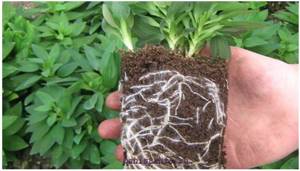
Drainage is placed at the bottom of the hole; it can be a handful of small expanded clay or crushed stone. Then a layer of compost 70-80 mm thick is placed in the hole. After which the plant is transferred along with a lump of earth or planted directly in a peat pot, if the seedling was grown in it. The voids are filled with soil. The soil surface around the bushes is compacted. After planting, the plant is watered.
In the future, the alstroemeria in the garden is watered in a timely manner, periodically fed, the cheesecakes are weeded and the surface of the soil around the bushes is loosened.
In addition, the plant must be inspected for pests and all kinds of diseases. It is necessary to prepare it for wintering. It is best to mulch the soil around the bush. Weeding and loosening the soil surface can be carried out through the mulch layer without removing it.
Alstroemeria: temperature
Alstroemeria in the garden grows best at a temperature of 23⁰C or more. The bushes begin to actively grow their root system, and then begin to grow and bloom.
During the flowering period, you need to pick off faded flowers and thin out the bushes if they become too dense. When thinning alstroemeria, thin, weakened stems that grow inside the bush are cut out.
Alstroemeria: watering
Water the plant moderately, as needed. If it rains from time to time, watering is carried out once a week. During dry periods, alstroemeria is watered twice a week. The soil surface should be constantly damp.
Important!!!
With excessive watering, the root system can rot, and if the flower does not have enough water, it will lose its decorative effect.
Alstroemeria: feeding
In order for the greenery of the bushes to have a rich color and flowering to be intense, alstroemeria needs to be fertilized 3 times a month. Complex fertilizers for flowering plants are suitable for feeding. In the initial growth phase, the plant needs a large amount of nitrogen, and for the formation of buds and active flowering, alstroemeria needs phosphorus. Periodically, wood ash should be scattered under the bushes.
Subtleties of landing
In order for young alstroemerias to quickly take root in open ground, they are planted in dry soil, choosing a clear sunny day for the procedure. A little organic fertilizer is added to the hole. There is no need to deepen the seedlings; it is best to bury them at the same level as the seedlings were when grown at home in a container. If bulbs are used, they are buried to a depth of no more than 20 cm.
Alstroemeria bushes grow quite strongly and branch well, so they will need space for uniform development. Holes in the same row are made at a distance of 30–40 cm from each other. Between the rows leave 60 to 20 cm of free space, focusing on the size of the young bushes and the strength of their growth.
You can count on abundant flowering of alstroemeria only by mulching the soil. For this procedure, sheet compost is most often used; peat can also be used. The composition is scattered generously around the seedlings, avoiding contact with their tops. The mulch layer should be thick and at least 7.5 cm. This is necessary to protect the plant’s root system from heat. A peculiarity of Peruvian lilies is that when the soil heats up above 23°, their tubers enter a phase of intensive growth, which has a bad effect on the formation of buds. In addition, mulch will help control weeds and keep the soil loose.
Planting is completed by abundant watering until the soil is completely moistened.
Alstroemeria: types, photos
Gardeners love to grow alstroemeria species: psittacina, haematantha, nana, brasiliensis, aurea, aurantiaca and others. In the flower garden you can find hybrids and varieties of this crop. The varieties presented below are the most popular among gardeners:
Alstroemeria Alicia
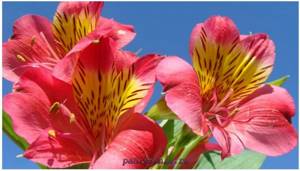
This hybrid has white or pink flowers. Blooms from June to September. Grows as a bush. In appearance it looks like a rose or chrysanthemum. The plant is planted at a distance of 30 cm, and planted in the soil to a depth of 20-25 cm. Well-lit places are chosen for planting the flower.
Alstroemeria Beauty
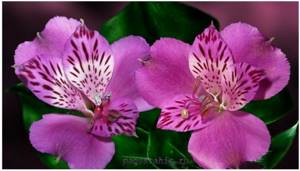
Altroemeria, a photo of this species is presented above, grows in height up to 1.3-1.7 m. The shoots of the flower are straight and strong. The flowers have a lilac or purple hue. The plant blooms in spring and again in early autumn.
Alstroemeria Harmoni (
Harmony)
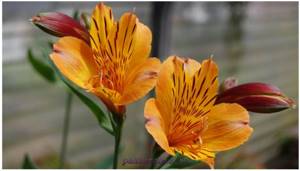
Tall bush, about 1.6 m. Powerful stems. It blooms in April–June, again in September, and manages to bloom before the onset of frost. The color of the flowers is bronze; the petals have a distinct pattern of black streaks.
Alstroemeria Canaria
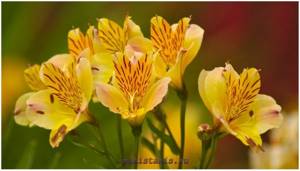
Grows up to 1.5 m in height, the shoots are thick. It blooms in May–June, again in September and fades before the first frost. The color of the flowers is canary yellow, the surfaces of the petals are decorated with small specks.
Alstroemeria King Cardinal
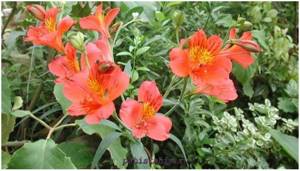
Bush height 1.5 m, peduncles weak. The color of the flowers is scarlet. Red alstroemeria grows poorly when there is a lack of light, and the stems may lie down. Flowering lasts from spring to autumn. The flowers look like an orchid.
Alstroemeria Regina
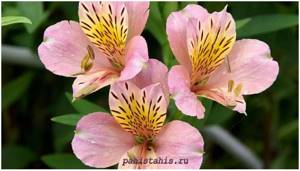
A very popular hybrid. The leaves are dark green, lanceolate in shape. The color of the funnel-shaped flowers is pink, and there are brown streaks on the surface of the petals. Alstroemeria rosea has an umbrella-shaped racemose inflorescence of 10–15 flowers. The plant blooms at the end of June and blooms until September.
Alstroemeria White Wings
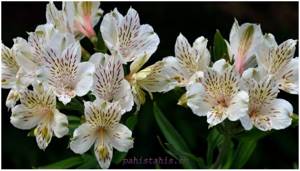
Bush height 2 m, powerful shoots. The leaves are large. The flowers are white, attractive in shape. Alstroemeria is white throughout the summer with a break of several weeks in July–August. White alstroemeria is suitable for cutting.
Alstroemeria Virginia
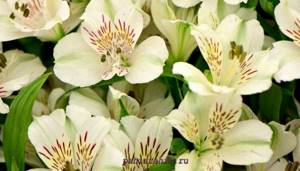
The height of the bush is about 0.7 m. Powerful stems are decorated with large white flowers. The edges of the petals of the flowers are wavy. Blooms from June until the first frost. One of the largest varieties.
Alstroemeria Orange Queen
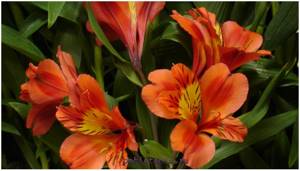
Decorative perennial flower. The height of the plant is about 0.7 m. The color of the flowers is apricot, and there are brown spots on the surface of the petals. This variety is planted not only in the garden, but also indoors, in order to make the interior bright. Orange alstroemeria is a heat-loving plant and in winter it requires shelter from the cold. The variety is unpretentious. Can grow in any soil, in bright sun or shade.
Alstroemeria is a garden decoration. And if you want to add an interesting color to your flowerbed, then this flower should not be discounted.
Basic rules of care
Although the epithets “capricious” and “demanding” do not apply to this flower, alstroemeria still needs some care. Peruvian lilies are very moisture-loving and do not tolerate dry soil. But excess moisture will not benefit the bushes: in waterlogged soil, the roots are quickly affected by rot. Therefore, when the planting is left behind, and the flowers have taken root in the open ground, water them often so that even the surface layer of the earth does not dry out too much, but in moderation.
You can maintain the moisture level plants need by mulching and regularly loosening the soil around them.
Caring for alstroemeria includes mandatory feeding. It is done often, every week. At the initial stages of seedling development, complex mineral compositions containing a lot of potassium are used for fertilization. When the plant reaches its first buds, fertilizing is done with a mineral mixture specially designed for flowering plants with a low percentage of nitrogen.
Organic fertilizers loved by many gardeners - bird droppings, mullein - are also suitable for Peruvian lilies. But here it is important to be careful and not to overdo the dosage, otherwise you can burn the roots of the delicate plant. Natural nutritional compounds are added in small quantities, using only well-rotted and highly diluted substances.
Description and photo
Alstroemeria is a herbaceous perennial that can reach a height of up to 2 meters. There are false and real straight shoots. The false stem bears light green leaves, large and wavy.
A special feature is the twisted leaves. Looking closely at the flower, you can see that the upper leaves are directed downwards, and the lower ones look up.
Buds form on the true stem.
Each alstroemeria peduncle contains up to 20 buds, which are arranged in two rows.
To prevent the plant from bending towards the ground and falling, it is tied to a trellis.
Do I need to prune alstroemeria?
Proper planting and care of alstroemeria will definitely lead to its flowering. It happens very intensely. Up to 80–130 very small buds can form on one bush. To improve the appearance of the plant, they resort to pruning. It is carried out as needed throughout the growing season.
- In the spring, when the first shoots appear, the bush is thinned out, without regret getting rid of weak branches, leaving only the most powerful ones. During the first pruning, alstroemeria loses about a third of all its shoots.
- Further care consists of constant monitoring of the plant, timely disposal of drying foliage and wilted flowers. Old shoots without buds are also removed, cutting them at a height of 10-15 cm from the root.
Thanks to these simple measures, alstroemerias do not lose their attractiveness throughout the summer, and their flowers become larger. Pruning also reduces the risk of plants being damaged by diseases and pests.
Known varieties of Alstroemeria
Alstroemeria has gained a huge reputation among breeders. Today there are over two hundred types of this flower. The following types of alstroemeria have the gigantic love of gardeners:

- Alicia. Pleiochasia is a tender pink color.
- Golden. The stems have every chance of being up to 1 meter in height, and the inflorescences have a striking orange color.
- Lemon. It is distinguished by huge flowers of an unusual color: bright lemon with a slight green tint.
- Virginia. The shoots are low, massive, strong. The inflorescences are snow-white, large.
- Blood-flowered. There can be up to 15 buds in 1 inflorescence. Scarlet petals have yellowish dots.
- Brazilian lily. The bush can grow up to 2 meters in height.
Preparing for winter
Alstroemeria varieties are diverse, and their number inspires awe: more than 190 varieties of the plant have already been bred. Most of them love warmth and do not tolerate frosty winters well, although there are some that can survive in extreme cold (down to -25°C). Therefore, with the arrival of autumn, the perennial Peruvian lily requires special care.
Watering is stopped completely. After the bush has flowered, it is pruned, leaving about 6–7 cm above the ground. It is important not to miss the moment and do this before the first frost. Then the plant is tightly covered. You can use fallen pine needles, spruce or pine branches, dry leaves, and straw for this. A plastic film is laid on top, fixing it with a layer of earth or mulch. Under such a warm “fur coat,” alstroemeria are not afraid of the cold.
In northern latitudes, where winters are very long and severe, it is not recommended to leave plants to overwinter in the open air. Experts advise removing tubers from the soil before the onset of frost and storing them in basement-type rooms in which the air has a low but positive temperature.
To avoid rotting of the roots of a dug-out flower, you should not completely remove the soil from them; you just need to slightly dry the lump of earth along with the tuber.
Alstroemeria is a very unusual plant that can bring exotic charm to any corner of the garden, decorate and enliven even the simplest bouquet. For all its obvious tenderness and fragility, this mountain flower has amazing resilience.
You should not doubt your abilities and be afraid of possible difficulties, because they are unlikely to arise when growing alstroemeria. Caring for it is not much different from caring for flowering plants that gardeners are already familiar with. Compliance with the basic rules of planting and watering, frequent fertilization and regular pruning are the basic principles on which the successful breeding of alstroemeria is based. You just have to try, and these beauties will definitely win your heart!
Alstroemeria is a blooming ornamental crop, which nowadays can often be found in almost every more or less large flower shop. Moreover, these flowers can be seen in stores much more often than in flower beds, household plots or garden plots. This is a very fashionable crop today, the flowers of which look great in absolutely any bouquet and harmoniously combine with most other popular flowers.
According to professional florists, it is best combined with cornflower when cut. Many of our contemporaries often mistakenly believe and confuse this flower with a lily or daylilies. However, in fact, alstroemeria have absolutely nothing to do with these cultures.
Just recently, growing alstroemeria at home and in open ground has become popular in our country. Moreover, if you correctly study the recommendations of experienced gardeners, then planting and caring for these very beautifully flowering plants will be quite simple and even a novice gardener can do it.
The shrub can be propagated in two ways:
- bush dividing method;
- using seeds.
Naturally, purchasing a ready-made adult plant and propagating it by dividing it is a much simpler undertaking than growing it from seeds. Moreover: if such a plant is grown using seeds, then its flowering will not occur soon - approximately after 2-3 years from the moment when planting was done, and even provided that the care was carried out correctly. At the same time, it is not always possible to purchase a bush (i.e., a cutting) of exactly the variety that you want.
In this case, you will have to master the process of growing from seeds. It also cannot be called particularly difficult - in any case, it is not much more difficult than growing asters at home.
In general, there are two ways to do this:
- By sowing seeds directly into open ground.
- Initially, grow seedlings from seeds, and only then transplant the sprouts into the soil.
When there is a desire to get the highest quality result, experts recommend using the second method, that is, seedlings. Sowing seeds for seedlings should be done in February. There are no special features of growing seedlings - this process is characterized by the same rules as for growing seedlings that are popular today. Planting seedlings of this shrub in open ground conditions should be carried out at the end of May, when the air temperature is already constant, i.e. it is always warm outside. Caring for seedlings planted in the ground does not require much effort. But, of course, you should definitely familiarize yourself with the recommendations of experienced gardeners and study all the features that competent care for fledgling sprouts that have just been transplanted into the ground has.
In the event that you manage to grow or buy an adult bush of a sufficiently large size, it should be divided. Flower growers recommend performing this kind of procedure in the summer after the end of the flowering period of this plant. Nevertheless, many experts argue that it is possible to divide alstroemeria, not only in the summer months, but also in the fall after flowering, as well as in the spring season - when the growing season is at the very beginning. The division procedure must be carried out extremely carefully! If the bush is not very large, you should not try to divide it into a large number of parts. It is optimal to divide the bush into 2, maximum 3 parts. At the same time, the roots of each part must be strong and well developed - otherwise you will have to wait a very long time for the onset of the flowering period.
Planting procedure: process features
Choosing the right place in which to plant such a plant is an extremely important aspect of growing alstroemeria. The quality of the plant’s flowering largely depends on this. The planting area should be well lit and have good, light soil. Doesn't feel good on heavy soil. When there is no special choice in terms of area, it is necessary to lighten the ground - for this purpose, you need to add a ripper to the soil. Experienced gardeners recommend using rotted manure, leaf compost, and high-moor peat as a cultivator.
According to experts, lighting in this case is also of great importance. However, one feature should be taken into account: in conditions of high soil temperatures (23 degrees Celsius and more), intensive development of the roots of the shrub begins to occur, the formation of large tubers, which, from a certain point of view, is not bad. But such a situation will lead to damage in terms of flowering. On overheated soil, it may not begin to bloom at all. Solving this problem is relatively simple - you should protect the soil around the root system of the bush with mulch - in addition to protecting it from overheating, it will also help to additionally retain moisture in the soil.
There is also this feature: if you want alstroemeria to bloom in the spring-summer period, then the planting of the delenka bush should be carried out in the autumn season (from the beginning of September to the end of October).

